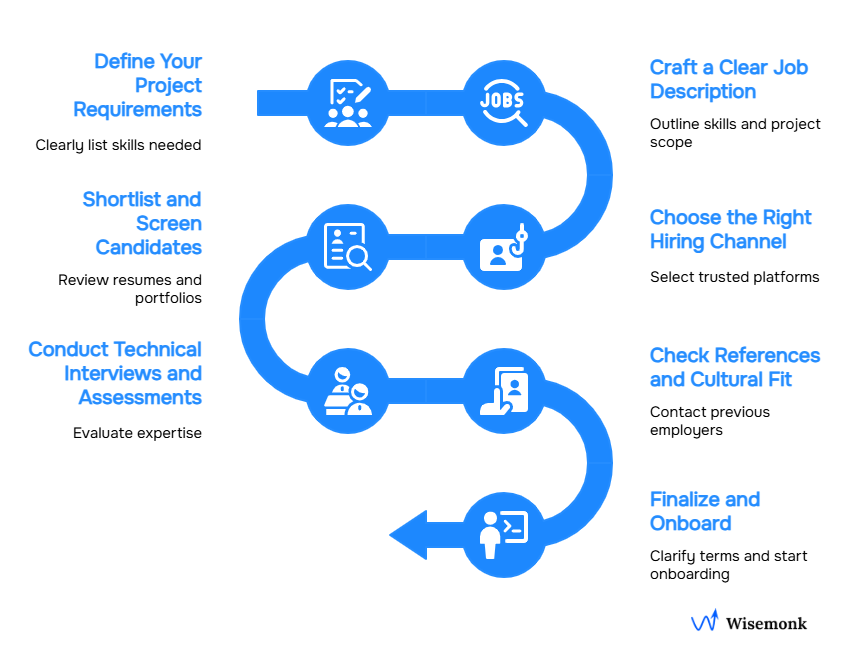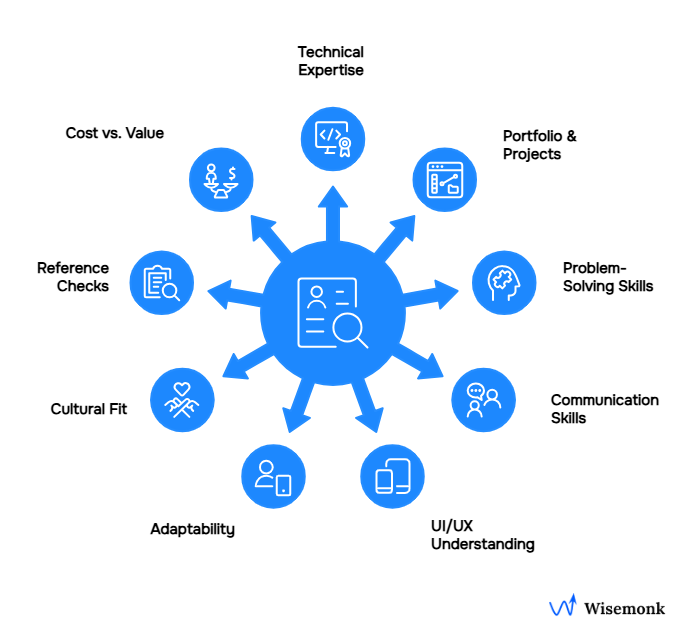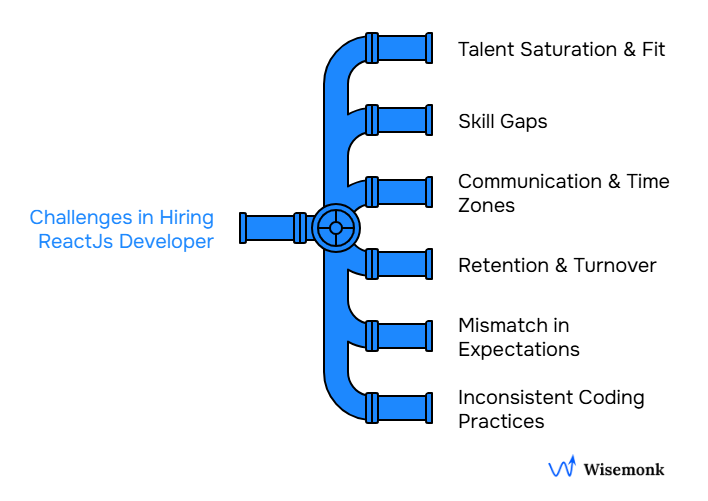Looking to hire React JS developers in India but confused by where to begin? This guide is for business owners, tech leads, and hiring managers tired of facing hidden costs, mismatched hires, and project delays. We’ve helped global teams overcome these headaches, so we’ll walk you through the real challenges, what to look for, how to find the right fit, and how to optimize costs, without losing quality. Let’s make your next hiring move smarter and simpler!
What essential skills and expertise do top ReactJS Developers possess?[toc=Skills & Expertise]
When it comes to hire ReactJS developers in India, our experience guiding both startups and enterprise clients has taught us that there’s a clear difference between average and standout ReactJS developers.
- Strong command of JavaScript & React JS: Top developers aren’t just familiar with js development, they excel at leveraging the latest ES6+ features, handling the virtual DOM, and understanding the nuances of React framework and React Router for building responsive user interfaces.
- Hands-on experience with reusable components & dynamic web apps: We’ve seen dedicated React JS developers who are skilled at creating and maintaining modular and reusable components, resulting in faster development of scalable web applications and dynamic web apps.
- Proficiency in integration & modern development tools: Working efficiently with RESTful APIs, GraphQL, and a variety of development tools like Git, Redux, and testing frameworks (Jest or React Testing Library) is non-negotiable for experienced ReactJS developers.
- Expertise in responsive & interactive user interfaces: In our projects, skilled react developers who master CSS frameworks (like Bootstrap or Tailwind) and ensure seamless implementation across devices contribute to improved performance and user satisfaction.
- Experience in support & maintenance services: Developers who demonstrate ongoing support, debugging, and a proven track record of optimizing existing web apps or mobile apps add a real advantage to your development team.
- Collaboration & communication: Effective react.js developers in India are great collaborators, whether a part of a dedicated team or offering remote react developers support. Their ability to work within flexible engagement models and coordinate with a project manager ensures smoother project delivery.
A developer’s ability to rapidly learn, solve real problems, and contribute new ideas often makes an even bigger impact than their resume suggests. Invest in those who are passionate about both growth and results.
How to hire a ReactJS Developer in India?[toc=Hiring Steps]
From guiding multiple businesses on this journey, we’ve noticed the process to hire React JS developers in India gets much smoother when you follow a clear step-by-step approach:

Step 1: Define Your Project Requirements
Clearly list the skills you need, whether it’s frontend, full-stack, experience with React.js plugins, Redux, or server side rendering. Align on whether you need a dedicated React developer, a short-term freelancer, or an entire development team for your web applications.
Step 2: Craft a Clear Job Description
Write a job description that outlines must-have React JS development skills, project scope, expected deliverables, and any preferences for work models (remote, in-house, or dedicated team).
Step 3: Choose the Right Hiring Channel
Use trusted platforms: LinkedIn, tech job boards, or partner with recruitment agencies or a React JS development company that specializes in vetting React developers in India. You can also check tech communities like GitHub or Stack Overflow for top portfolios.
Step 4: Shortlist and Screen Candidates
Review resumes, portfolios, and previous projects. Focus on technical expertise in React JS, JavaScript, and related tools. Assess communication skills and how well they’d fit your team’s culture.
Step 5: Conduct Technical Interviews and Assessments
Arrange coding assessments, technical interviews, and problem-solving tests. Evaluate their expertise with reusable components, APIs, and ability to optimize dynamic web apps.
Step 6: Check References and Cultural Fit
Contact previous employers or clients, and consider a probationary period or trial task to evaluate real-world performance and how they work with your existing team.
Step 7: Finalize and Onboard
Once you select your ideal React JS developer, clarify terms, confirm timelines, and start onboarding. Make sure you’re aligned on communication tools and development process for your project.
Following these steps helps you build a reliable, dedicated React JS development team in India that’s aligned with your project goals and business values.
What factors should you consider when hiring a ReactJS Developer in India?[toc=Key Consideration]
Choosing the right ReactJS developer can make or break your web app project, especially when building your team remotely or offshore. Based on what we’ve learned guiding a variety of businesses, here’s what really matters:

- Technical Expertise & Practical Experience: Look for a solid foundation in JavaScript (ES6+), deep familiarity with React.js concepts (like hooks, lifecycle methods, and the virtual DOM), and proven experience building component-driven, production-level applications. Experience with supporting technologies such as Redux, React Router, TypeScript, and RESTful APIs is a must-have.
- Portfolio & Real-World Projects: Always check their portfolio or GitHub, hands-on work on real web development projects demonstrates their expertise and ability to create scalable, maintainable apps, not just small demo tasks.
- Problem-Solving & Analytical Skills: Great React JS developers can troubleshoot, debug, and optimize code. They should be able to tackle technical challenges and quickly adapt to new development tools or project requirements.
- Communication & Team Fit: Whether you’re building a remote or dedicated team, communication is critical. Prioritize developers who can explain technical concepts clearly, give and receive feedback, and collaborate smoothly with your project manager and other stakeholders.
- Understanding of UI/UX & Responsive Design: Developers should be comfortable with front-end best practices and have an eye for responsive user interfaces, ensuring your web app looks and performs well across devices.
- Adaptability to Modern Tech Stacks: Strong candidates are proactive about learning new frameworks, libraries, and tools (like Next.js, GraphQL, or CSS-in-JS solutions) to keep your project at the forefront of innovation.
- Cultural & Organizational Fit: Make sure the developer aligns with your company’s values and work style. A good cultural fit helps reduce friction, boosts collaboration, and supports long-term project success.
- Reference & Background Checks: Get feedback from previous employers or clients to gauge reliability, on-time delivery, and general work ethic. This can help you spot red flags early.
- Cost vs. Value: While cost-effectiveness is a key advantage of India, don’t compromise on quality for the lowest rate. Balance technical expertise, relevant experience, and communication skills with competitive compensation.
Keeping these factors in mind can save you from costly hiring mistakes and ensure you’re bringing the right React JS developer onboard for your next web or mobile app project.
What is the typical salary range for ReactJS Developers in India?[toc=Salary Range]
When hiring ReactJS developers in India, understanding the current salary trends can help you set realistic expectations and negotiate effectively. Here’s a breakdown based on recent data and real-world hiring experience:
This table is prepared using data from top companies in India to assist those looking to hire ReactJS Developers from India, showing the compensation offered to these developers at various experience levels. Besides competitive salaries, these companies often provide attractive benefits such as paid time off (PTO) policies, family insurance coverage, flexible working hours, and professional development opportunities.
How can you optimize the cost of hiring a ReactJS Developer without compromising quality?[toc=Cost Optimization]
Optimizing costs when you hire React JS developers in India doesn’t have to mean accepting lower standards. Based on our extensive work with companies of all sizes, here are the strategies that have consistently delivered value while maintaining high-quality results:
- Choose the right engagement model
- Clearly define project scope and requirements
- Select developers based on both skills and efficiency
- Leverage offshore and remote talent pools
- Utilize trusted React JS development companies
- Invest in continuous communication and project management
- Focus on long-term relationships
What challenges you might face when hiring React JS Developers in India?[toc=Challenges]
Hiring ReactJS developers in India offers immense benefits, but it’s not without its challenges. Having helped several organizations, from startups to global enterprises, we’ve seen some common hurdles that can impact the hiring process if you're not prepared.

- Talent Saturation & Identifying the Right Fit: With React JS being such a popular framework, the market’s full of applicants. But not all react developers offering their services are at the level your project may demand. Sifting through profiles to find truly skilled and experienced React JS developers can be time-consuming without a clear evaluation strategy.
- Skill Gaps in Real-World Application: In our experience, some candidates may have strong theoretical knowledge but fall short on practical implementation, especially when it comes to advanced concepts like reusable components, virtual DOM optimization, or building scalable SPAs.
- Communication & Time Zone Barriers: Working with remote React JS developers across time zones can lead to delays or misalignment if communication isn’t well-structured. Having a dedicated project manager or using collaboration tools can help bridge this gap.
- Retention & Developer Turnover: Skilled React JS developers are in demand, which means high turnover if not managed carefully. We've seen projects get derailed because of sudden exits; offering growth opportunities and maintaining engagement helps reduce this risk.
- Mismatch in Expectations: Without a well-defined scope and onboarding process, developers may miss the business context or UI/UX expectations, leading to increased revisions and delays.
- Inconsistent Coding Practices
Especially when hiring freelancers or assembling a team from different backgrounds, inconsistent coding styles can create long-term maintenance challenges. Code audits and setting upfront development standards help alleviate this.
While these challenges are real, they’re not roadblocks. With the right hiring process, tools, and collaboration model, you can navigate these issues effectively and build a strong React JS development team in India that delivers consistent value.
Conclusion
Hiring React JS developers in India is a smart move for growing businesses seeking technical expertise and value. With careful planning and clear communication, you gain access to skilled talent and innovative solutions. The key is balancing quality, cost, and team fit for the best project outcome. Approach the process thoughtfully, and India’s developer pool can become your competitive advantage.
Ready to build your high-performing React JS team in India? Contact us today to discuss your hiring needs!





































